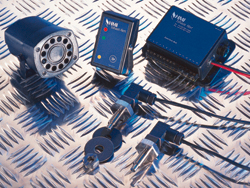An exhaust alert system can sense overheating caused by a plastic bag or seaweed being sucked into the intake, or by a problem with the water pump, and warn you before serious damage occurs.
Sensing overheating in marine exhaust systems
Marine diesel exhaust systems are designed to take temperatures of only 120°C. The exhaust gases, however, may reach more than 500°C. To cool the gases, the exhaust depends on a free flow of cooling water from the engine. This flow can be cut off, by a plastic bag or seaweed being sucked into the intake, or by a problem with the water pump. The exhaust temperature will rise immediately to around 450°C, the exhaust will overheat and may be seriously damaged. In most situations Exhaust Alert will warn you before serious damage occurs.
Can it be used with any engine?
The HMI Exhaust Alert is designed for use with diesel inboard engines between 5hp and 1200hp, with rubber hose exhaust systems. It cannot normally be used with outdrive/ sterndrive engines or with petrol engines.
With twin engines?
No problem. The HMI Exhaust Alert is available for single engines, twin engines, or for twin engine craft with generators.
With two helm stations?
No problem. Just order the unit with an extra helm display and wire this in.
Can I replace the sensor?
Yes. Spare sensors are readily available if the overheat was so serious that it burnt out the sensor.
Will the system go off without the engine?
The HMI Exhaust Alert self-tests continuously and will detect voltage changes. It is important that it is live only when the engine is turned on.
Will it protect the whole exhaust?
Exhaust Alert will normally spot trouble before serious damage occurs to quality exhaust hose or other components in the system. Plastic or polypropylene components will not be protected as their melt point is too low.
Will it protect my engine?
The HMI Exhaust Alert is designed to protect only the exhaust. The system should not be regarded as an engine protection device, although it may beat the engine temperature sensors when the engine is cold.
Can I fit it myself?
More than half the Exhaust Alerts sold are fitted by the owner – often with help. You will need to remove the exhaust hose from the engine to fit the sensor, but once this is done the rest of the work is fairly simple to someone with wiring skills.
Further information on Halyard’s Sea Strainer Alarm



